RENAULT WIND 2012 1.G Workshop Manual
Manufacturer: RENAULT, Model Year: 2012, Model line: WIND, Model: RENAULT WIND 2012 1.GPages: 185, PDF Size: 5.52 MB
Page 51 of 185
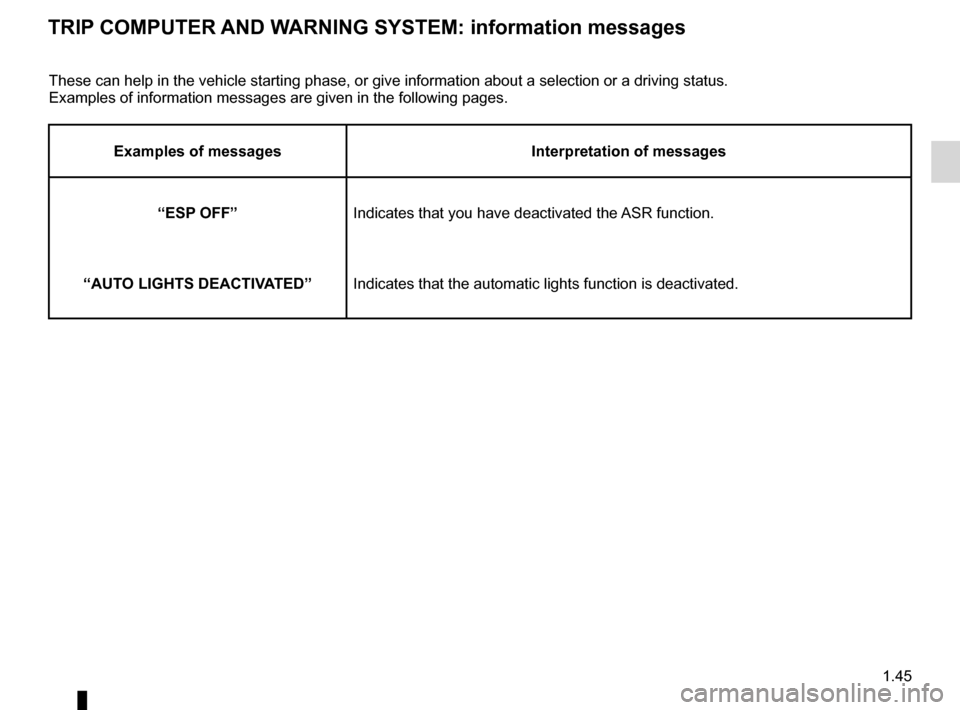
1.45
ENG_UD24361_1
Ordinateur de bord : messages d’information (E33 - X33 - Renault)
ENG_NU_865-6_E33_Renault_1
TRIp COMpUTER AND WARNING SYSTEM: information messages
These can help in the vehicle starting phase, or give information about a selection or a driving status.
Examples of information messages are given in the following pages.
Examples of messages Interpretation of messages
“ESp OFF” Indicates that you have deactivated the ASR function.
“AUTO LIGHTS DEACTIVATED” Indicates that the automatic lights function is deactivated.
Page 52 of 185
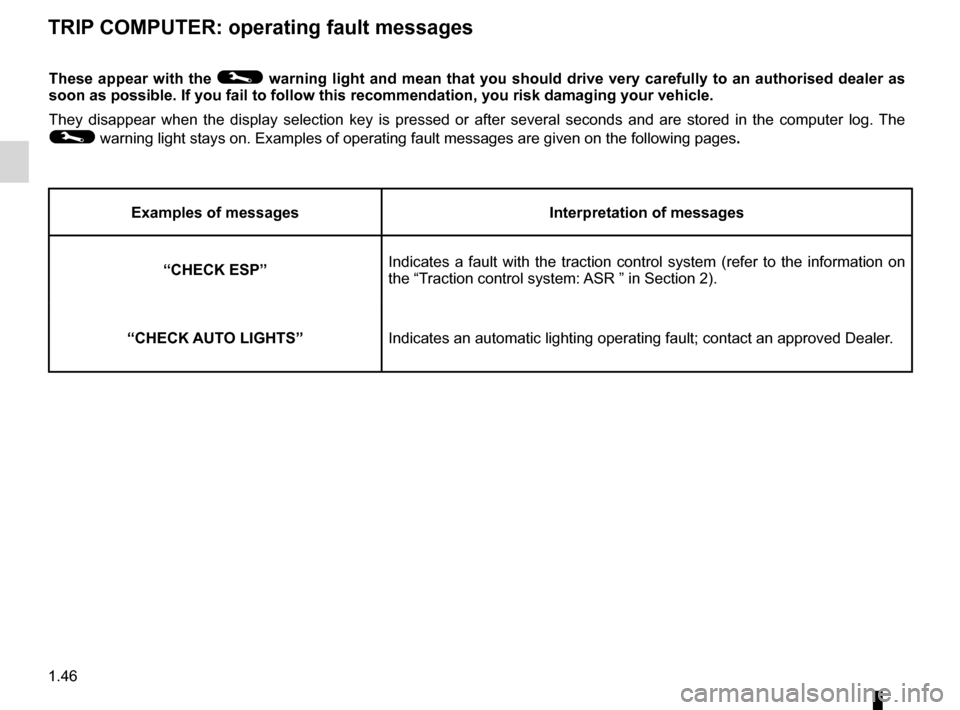
1.46
ENG_UD24362_1
Ordinateur de bord : messages d’anomalies de fonctionnement (E33 - X33 - Renault)
ENG_NU_865-6_E33_Renault_1
TRIp COMpUTER: operating fault messages
These appear with the © warning light and mean that you should drive very carefully to an authorised dealer as
soon as possible. If you fail to follow this recommendation, you risk damaging your vehicle.
They disappear when the display selection key is pressed or after several seconds and are stored in the computer log. The
© warning light stays on. Examples of operating fault messages are given on the following pages .
Examples of messages Interpretation of messages
“CHECK ESp” Indicates a fault with the traction control system (refer to the information on
the “Traction control system: ASR ” in Section 2).
“CHECK AUTO LIGHTS ”Indicates an automatic lighting operating fault; contact an approved Dealer .
Page 53 of 185
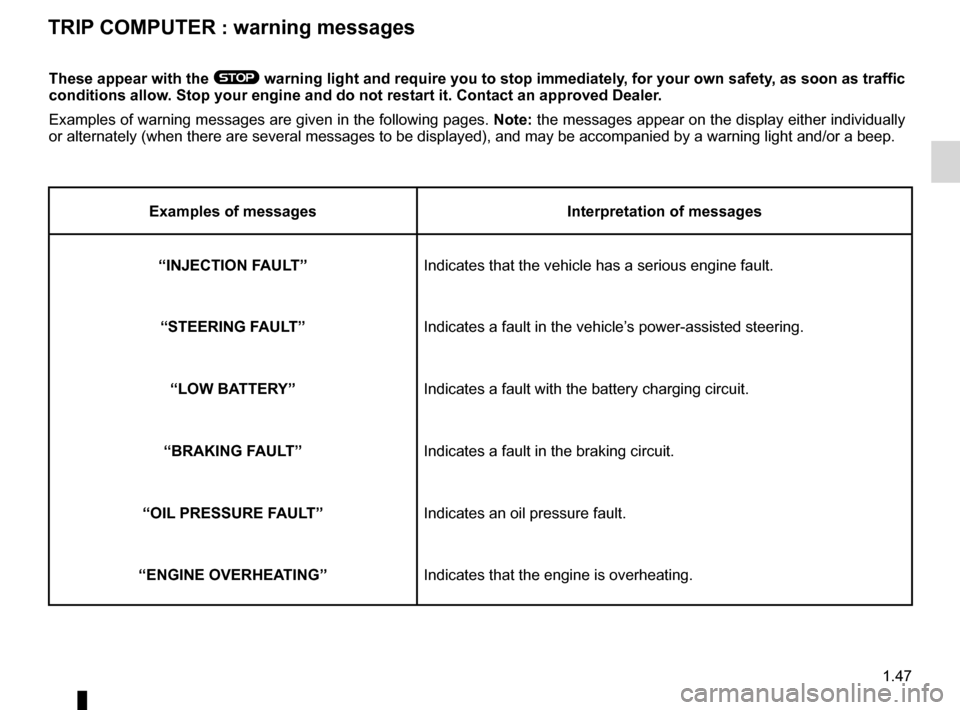
1.47
ENG_UD24363_1
Ordinateur de bord : messages d’alerte (E33 - X33 - Renault)
ENG_NU_865-6_E33_Renault_1
These appear with the ® warning light and require you to stop immediately, for your own safety, as soon as traffic
conditions allow. Stop your engine and do not restart it. Contact an approved Dealer.
Examples of warning messages are given in the following pages. Note: the messages appear on the display either individually
or alternately (when there are several messages to be displayed), and may be accompanied by a warning light and/or a beep.
Examples of messages Interpretation of messages
“INJECTION FAULT” Indicates that the vehicle has a serious engine fault.
“STEERING FAULT” Indicates a fault in the vehicle’s power-assisted steering.
“LOW BATTERY” Indicates a fault with the battery charging circuit.
“BRAKING FAULT” Indicates a fault in the braking circuit.
“OIL pRESSURE FAULT” Indicates an oil pressure fault.
“ENGINE OVERHEATING” Indicates that the engine is overheating.
TRIp COMpUTER : warning messages
Page 54 of 185
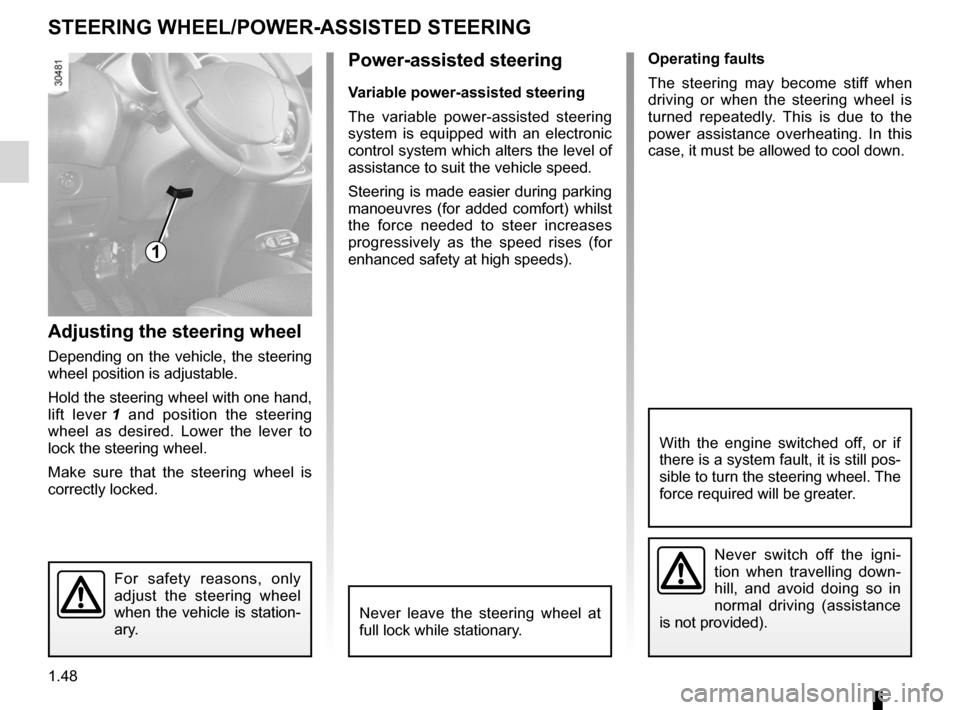
steering wheeladjustment ...................................... (up to the end of the DU)
power-assisted steering ........................(up to the end of the DU)
power-assisted steering ........................(up to the end of the DU)
1.48
ENG_UD11167_1
Volant de direction (E33 - X33 - Renault)
ENG_NU_865-6_E33_Renault_1
Operating faults
The steering may become stiff when
driving or when the steering wheel is
turned repeatedly. This is due to the
power assistance overheating. In this
case, it must be allowed to cool down.power-assisted steering
Variable power-assisted steering
The variable power-assisted steering
system is equipped with an electronic
control system which alters the level of
assistance to suit the vehicle speed.
Steering is made easier during parking
manoeuvres (for added comfort) whilst
the force needed to steer increases
progressively as the speed rises (for
enhanced safety at high speeds).
Steering wheel
Power-assisted steering
STEERING WHEEL/pOWER-ASSISTED STEERING
Never leave the steering wheel at
full lock while stationary.
Never switch off the igni -
tion when travelling down -
hill, and avoid doing so in
normal driving (assistance
is not provided).
With the engine switched off, or if
there is a system fault, it is still pos-
sible to turn the steering wheel. The
force required will be greater.
Adjusting the steering wheel
Depending on the vehicle, the steering
wheel position is adjustable.
Hold the steering wheel with one hand,
lift lever 1 and position the steering
wheel as desired. Lower the lever to
lock the steering wheel.
Make sure that the steering wheel is
correctly locked.
For safety reasons, only
adjust the steering wheel
when the vehicle is station-
ary.
1
Page 55 of 185

clock ..................................................... (up to the end of the DU)
clock ..................................................... (up to the end of the DU)
external temperature ............................ (up to the end of the DU)
indicators: exterior temperature indicator .......................... (current page)
1.49
ENG_UD11174_1
Heure et température extérieure (E33 - X33 - Renault)
ENG_NU_865-6_E33_Renault_1
Clock and exterior temperature
External temperature
indicator
As ice formation is related
to climatic exposure, local
air humidity and temperature, the
external temperature alone is not
sufficient to detect ice.
CLOCK AND EXTERIOR TEMpERATURE
Display A
With the ignition on, the clock and the
exterior temperature are displayed.
For your safety, we recom -
mend that you do not adjust
the clock while driving.
A
1
2
If the power supply is cut (battery
disconnected, supply wire cut, etc.),
the clock must be reset.
We recommend that you do not
adjust these settings while driving.
External temperature
indicator
Special note:
When the external temperature is be -
tween –3°C and +3°C, the °C charac -
ters flash (indicates risk of ice forma -
tion).
Resetting the clock
With the ignition on, press button:
1 for the hours;
2 for the minutes.
Note: for vehicles not fitted with but -
tons 1 and 2 , refer to the instructions
for the specific equipment (radio, etc.)
to discover the special features.
Page 56 of 185
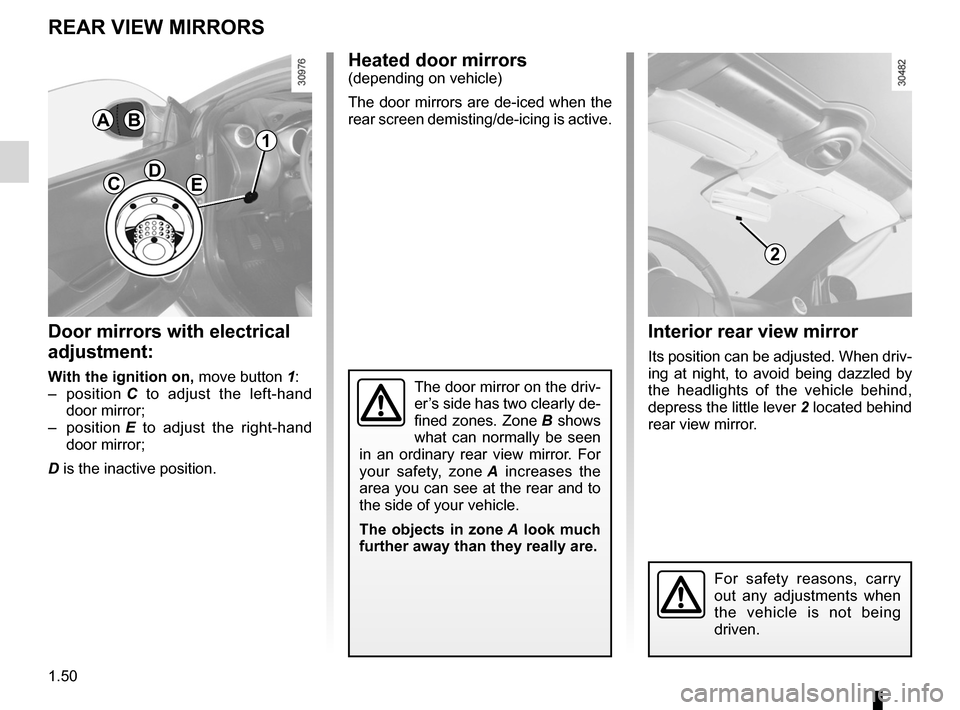
rear view mirrors ................................... (up to the end of the DU)
1.50
ENG_UD11175_1
Rétroviseurs (E33 - X33 - Renault)
ENG_NU_865-6_E33_Renault_1
Door mirrors
REAR VIEW MIRRORS
Door mirrors with electrical
adjustment:
With the ignition on, move button 1:
– position C to adjust the left-hand
door mirror;
– position E to adjust the right-hand
door mirror;
D is the inactive position.
Heated door mirrors(depending on vehicle)
The door mirrors are de-iced when the
rear screen demisting/de-icing is active.
The door mirror on the driv-
er’s side has two clearly de-
fined zones. Zone B shows
what can normally be seen
in an ordinary rear view mirror. For
your safety, zone A increases the
area you can see at the rear and to
the side of your vehicle.
The objects in zone A look much
further away than they really are.
Interior rear view mirror
Its position can be adjusted. When driv-
ing at night, to avoid being dazzled by
the headlights of the vehicle behind,
depress the little lever 2 located behind
rear view mirror.
For safety reasons, carry
out any adjustments when
the vehicle is not being
driven.
2
CDE
AB
1
Page 57 of 185
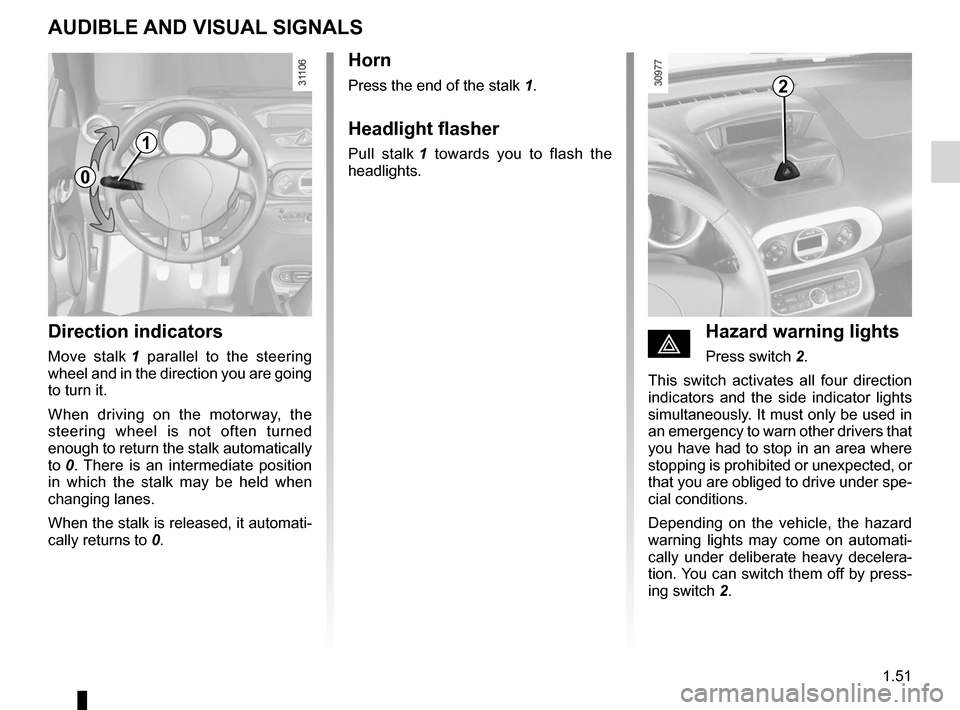
warning buzzer ..................................... (up to the end of the DU)
headlight flashers ................................. (up to the end of the DU)
indicators .............................................. (up to the end of the DU)
lights: hazard warning ............................... (up to the end of the DU)
lights: direction indicators .......................... (up to the end of the DU)
indicators: direction indicators .......................... (up to the end of the DU)
hazard warning lights signal ................. (up to the end of the DU)
hazard warning lights signal ................. (up to the end of the DU)
horn ...................................................... (up to the end of the DU)
horn: flash ................................................................. (current page)
horn: sounding the horn ............................................ (current page)
horn ....................................................................... (current page)
audible and visual signals .....................(up to the end of the DU)
1.51
ENG_UD11176_1
Avertisseurs sonore et lumineux (E33 - X33 - Renault)
ENG_NU_865-6_E33_Renault_1
Audible and visual signals
AUDIBLE AND VISUAL SIGNALS
Direction indicators
Move stalk 1 parallel to the steering
wheel and in the direction you are going
to turn it.
When driving on the motorway, the
steering wheel is not often turned
enough to return the stalk automatically
to 0 . There is an intermediate position
in which the stalk may be held when
changing lanes.
When the stalk is released, it automati-
cally returns to 0.éHazard warning lights
Press switch 2.
This switch activates all four direction
indicators and the side indicator lights
simultaneously. It must only be used in
an emergency to warn other drivers that
you have had to stop in an area where
stopping is prohibited or unexpected, or
that you are obliged to drive under spe-
cial conditions.
Depending on the vehicle, the hazard
warning lights may come on automati -
cally under deliberate heavy decelera -
tion. You can switch them off by press-
ing switch 2.
Horn
Press the end of the stalk 1.
Headlight flasher
Pull stalk 1 towards you to flash the
headlights.1
0
2
Page 58 of 185
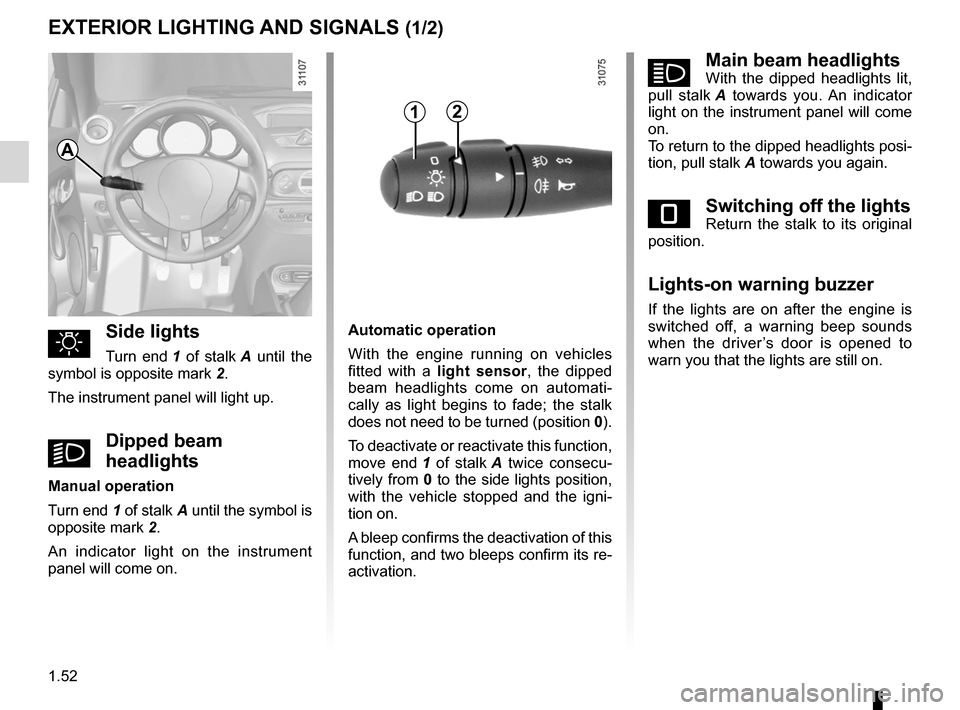
lighting:exterior ............................................ (up to the end of the DU)
instrument panel .................................................... (current page)
lights: side lights ......................................................... (current page)
lights: dipped beam headlights ................................... (current page)
hazard warning lights signal .................................. (current page)
signals and lights .................................. (up to the end of the DU)
lighting: instrument panel .............................................. (current page)
daytime running lights ............................................ (current page)
1.52
ENG_UD21753_2
Éclairages et signalisations extérieurs (E33 - X33 - Renault)
ENG_NU_865-6_E33_Renault_1
Jaune NoirNoir texte
áMain beam headlightsWith the dipped headlights lit,
pull stalk A towards you. An indicator
light on the instrument panel will come
on.
To return to the dipped headlights posi-
tion, pull stalk A towards you again.
eSwitching off the lightsReturn the stalk to its original
position.
Lights-on warning buzzer
If the lights are on after the engine is
switched off, a warning beep sounds
when the driver ’s door is opened to
warn you that the lights are still on.
Exterior lighting and signals
EXTERIOR LIGHTING AND SIGNALS (1/2)
uSide lights
Turn end 1 of stalk A until the
symbol is opposite mark 2.
The instrument panel will light up.
kDipped beam
headlights
Manual operation
Turn end 1 of stalk A until the symbol is
opposite mark 2.
An indicator light on the instrument
panel will come on.
A
Automatic operation
With the engine running on vehicles
fitted with a light sensor , the dipped
beam headlights come on automati -
cally as light begins to fade; the stalk
does not need to be turned (position 0).
To deactivate or reactivate this function,
move end 1 of stalk A twice consecu -
tively from 0 to the side lights position,
with the vehicle stopped and the igni -
tion on.
A bleep confirms the deactivation of this
function, and two bleeps confirm its re-
activation.
21
Page 59 of 185
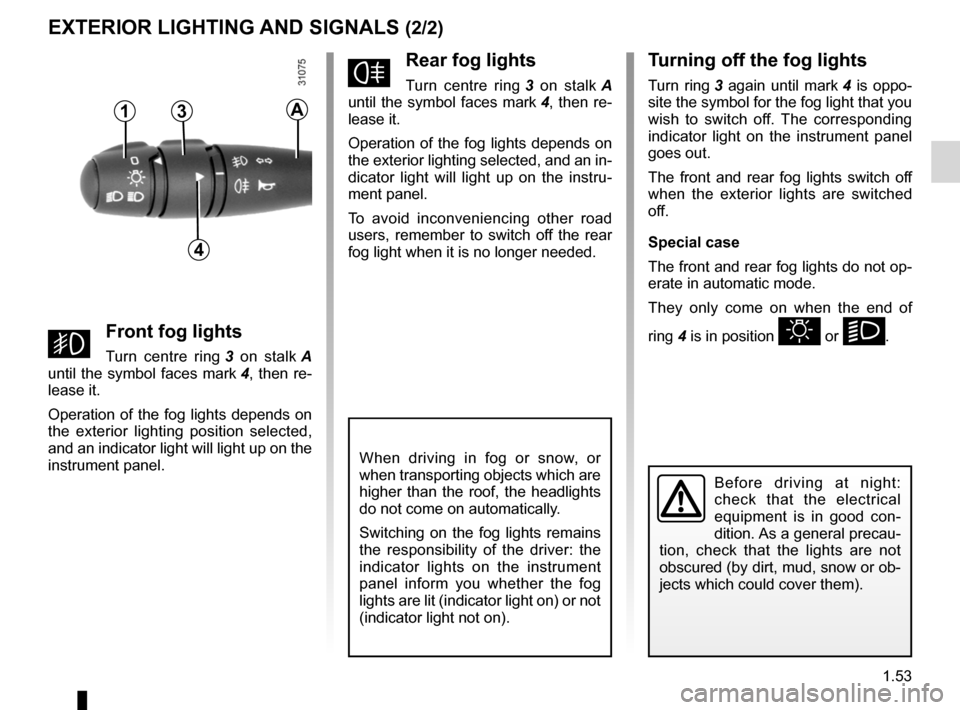
lights:main beam headlights ...................................... (current page)
warning buzzer ...................................................... (current page)
see-me-home lighting ............................................ (current page)
lights mobile directional ............................................. (current page)
JauneNoirNoir texte
1.53
ENG_UD21753_2
Éclairages et signalisations extérieurs (E33 - X33 - Renault)
ENG_NU_865-6_E33_Renault_1
Turning off the fog lights
Turn ring 3 again until mark 4 is oppo -
site the symbol for the fog light that you
wish to switch off. The corresponding
indicator light on the instrument panel
goes out.
The front and rear fog lights switch off
when the exterior lights are switched
off.
Special case
The front and rear fog lights do not op-
erate in automatic mode.
They only come on when the end of
ring 4 is in position
u or k.
EXTERIOR LIGHTING AND SIGNALS (2/2)
gFront fog lights
Turn centre ring 3 on stalk A
until the symbol faces mark 4, then re-
lease it.
Operation of the fog lights depends on
the exterior lighting position selected,
and an indicator light will light up on the
instrument panel.
Before driving at night:
check that the electrical
equipment is in good con -
dition. As a general precau -
tion, check that the lights are not
obscured (by dirt, mud, snow or ob-
jects which could cover them).
1A3
4
fRear fog lights
Turn centre ring 3 on stalk A
until the symbol faces mark 4, then re-
lease it.
Operation of the fog lights depends on
the exterior lighting selected, and an in-
dicator light will light up on the instru -
ment panel.
To avoid inconveniencing other road
users, remember to switch off the rear
fog light when it is no longer needed.
When driving in fog or snow, or
when transporting objects which are
higher than the roof, the headlights
do not come on automatically.
Switching on the fog lights remains
the responsibility of the driver: the
indicator lights on the instrument
panel inform you whether the fog
lights are lit (indicator light on) or not
(indicator light not on).
Page 60 of 185

wipers ................................................... (up to the end of the DU)
windscreen washer/wiper ..................... (up to the end of the DU)
windscreen washer ............................... (up to the end of the DU)
1.54
ENG_UD25520_2
Essuie-vitre / lave-vitre avant (E33 - X33 - Renault)
ENG_NU_865-6_E33_Renault_1
Jaune NoirNoir texte
Windscreen washers/wipers
SCREEN WASHER/WIpER (1/2)
nWindscreen wiper
With the ignition on, move
stalk 1:
A park
B intermittent wiping
The wipers will pause for sev -
eral seconds between sweeps.
Depending on the vehicle, it is pos-
sible to change the time between
sweeps by turning ring 2.
C normal wiping speed
D fast wiping speed
Special note
When driving every time the vehi -
cle stops, the wipers slow down, e.g.
fast wiping speed is reduced to normal
wiping speed.
As soon as the vehicle moves off,
wiping will return to the speed originally
selected.
Any action on stalk 1 overrides and
cancels automatic operation.
Vehicles with automatic wiper
function
With the engine running, move
stalk 1:
A park
B automatic wiper function
When this position is selected, the
system detects the presence of
water on the windscreen and triggers
wiping at a suitable wiping speed. It
is possible to change the time be -
tween sweeps by turning ring 2.
C normal wiping speed
D fast wiping speed
With the vehicle stationary, if for
any reason the wipers cannot move
(e.g. stuck to windscreen by ice),
the system will automatically cut off
the power supply to the wipers.
2
A
B
C
D
1
1